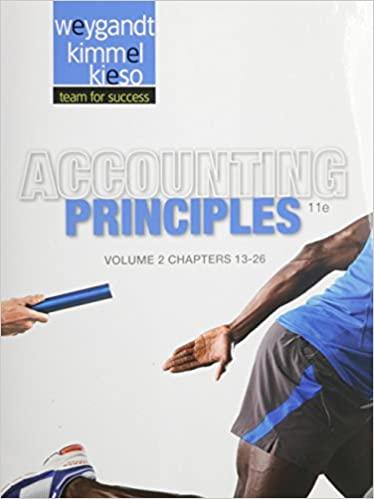Question
Question : For Kroger footnote 1: What cost flow assumption method does Kroger use for food? Does this match the actual flow of goods through
Question : For Kroger footnote 1: What cost flow assumption method does Kroger use for food? Does this match the actual flow of goods through the stores? What is the explanation for this?
Description of Business, Basis of Presentation and Principles of Consolidation
The Kroger Co. (the Company) was founded in 1883 and incorporated in 1902. As of January 28, 2017, the Company was one of the largest retailers in the world based on annual sales. The Company also manufactures and processes food for sale by its supermarkets. The accompanying financial statements include the consolidated accounts of the Company, its wholly-owned subsidiaries and the variable interest entities in which the Company is the primary beneficiary. Intercompany transactions and balances have been eliminated.
Property, Plant and Equipment
Property, plant and equipment are recorded at cost or, in the case of assets acquired in a business combination, at fair value. Depreciation and amortization expense, which includes the depreciation of assets recorded under capital leases, is computed principally using the straight-line method over the estimated useful lives of individual assets. Buildings and land improvements are depreciated based on lives varying from 10 to 40 years. All new purchases of store equipment are assigned lives varying from three to nine years. Leasehold improvements are amortized over the shorter of the lease term to which they relate, which generally varies from four to 25 years, or the useful life of the asset. Food production plant and distribution center equipment is depreciated over lives varying from three to 15 years. Information technology assets are generally depreciated over five years. Depreciation and amortization expense was $2,340 in 2016, $2,089 in 2015 and $1,948 in 2014.
Merchandise Costs
The Merchandise costs line item of the Consolidated Statements of Operations includes product costs, net of discounts and allowances; advertising costs (see separate discussion below); inbound freight charges; warehousing costs, including receiving and inspection costs; transportation costs; and food production and operational costs. Warehousing, transportation and manufacturing management salaries are also included in the Merchandise costs line item; however, purchasing management salaries and administration costs are included in the Operating, general and administrative line item along with most of the Companys other managerial and administrative costs. Rent expense and depreciation and amortization expense are shown separately in the Consolidated Statements of Operations.

Advertising Costs The Company's advertising costs are recognized in the periods the related expenses are incurred and are included in the "Merchandise costs" line item of the Consolidated Statements of Operations. The Company's pre- tax advertising costs totaled $717 in 2016, $679 in 2015 and $648 in 2014. The Company does not record vendor allowances for co-operative advertising as a reduction of advertising expense. Consolidated Statements of Cash Flows For purposes of the Consolidated Statements of Cash Flows, the Company considers all highly liquid debt instruments purchased with an original maturity of three months or less to be temporary cash investments. Segments The Company operates supermarkets, multi-department stores, jewelry stores, and convenience stores throughout the United States. The Company's retail operations, which represent over 98% of the Company's consolidated sales and EBITDA, are its only reportable segment. The Company's operating divisions have been aggregated into one reportable segment due to the operating divisions having similar economic characteristics with similar long-term financial performance. In addition, the Company's operating divisions offer customers similar products, have similar distribution methods, operate in similar regulatory environments, purchase the majority of the merchandise for retail sale from similar and in many cases identical) vendors on a coordinated basis from a centralized location, serve similar types of customers, and are allocated capital from a centralized location. Operating divisions are organized primarily on a geographical basis so that the operating division management team can be responsive to local needs of the operating division and can execute company strategic plans and initiatives throughout the locations in the operating division. The geographical separation is the primary differentiation between these operating divisions. The Company's geographic basis of organization reflects the manner in which the business is managed and how the Company's Chief Executive Officer, who acts as the Company's chief operating decision maker, assesses performance internally. All of the Company's operations are domestic The following table presents sales revenue by type of product for 2016, 2015 and 2014. Non Perishable () Perishable Fuel Pharmacy Other (3) 2016 2015 2014 Amount % of total Amount % of total Amount % of total $ 60,220 52.2 % $ 57,187 52.1 % $ 54,392 50.1 % 27,666 24.0% 25,726 23.4 % 24,178 22.3 % 13,979 12.1 % 14,802 13.5 % 18,850 17.4 % 10,432 9.0 % 9,778 8.9 % 9,032 8.3 % 3,040 2.7 % 2,337 2.1% 2,013 1.9 % Total Sales and other revenue $115,337 100 % $109,830 100 % $108,465 100 % (1) Consists primarily of grocery, general merchandise, health and beauty care and natural foods. (2) Consists primarily of produce, floral, meat, seafood, deli, bakery and fresh prepared. (3) Consists primarily of sales related to jewelry stores, food production plants to outside customers, data analytic services, variable interest entities, specialty pharmacy, in-store health clinics, digital coupon services and online sales by Vitacost.com
Step by Step Solution
There are 3 Steps involved in it
Step: 1

Get Instant Access to Expert-Tailored Solutions
See step-by-step solutions with expert insights and AI powered tools for academic success
Step: 2

Step: 3

Ace Your Homework with AI
Get the answers you need in no time with our AI-driven, step-by-step assistance
Get Started


